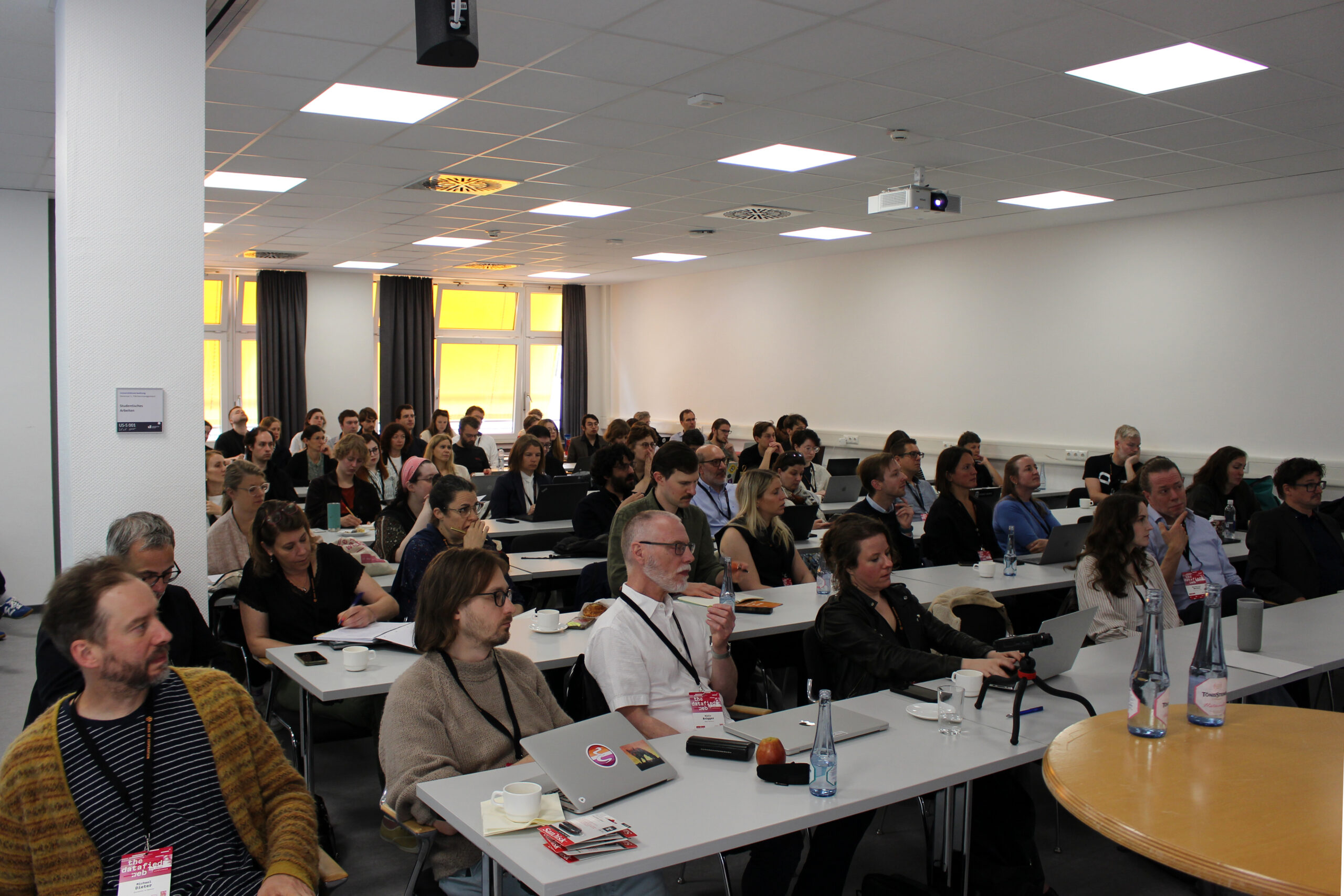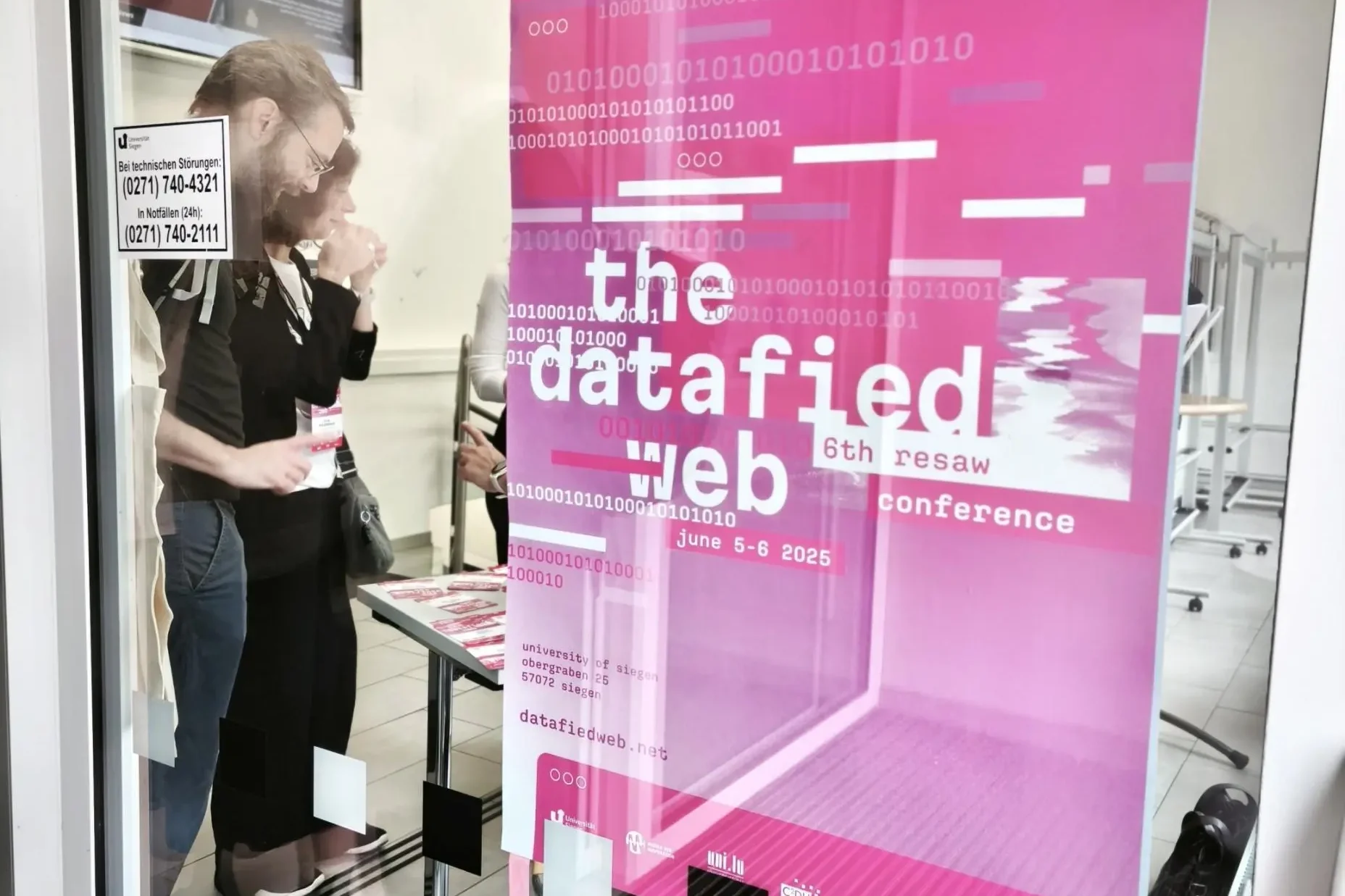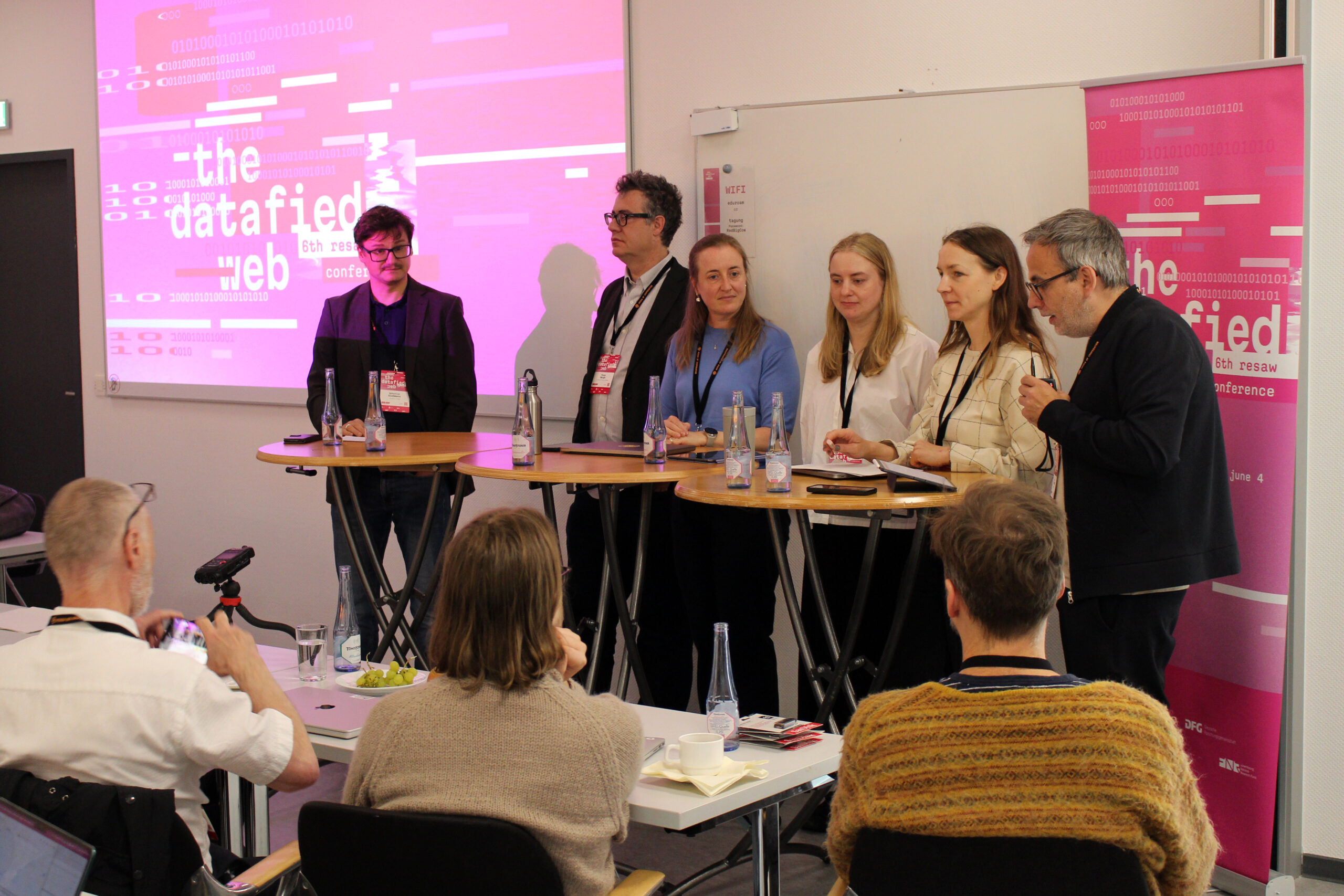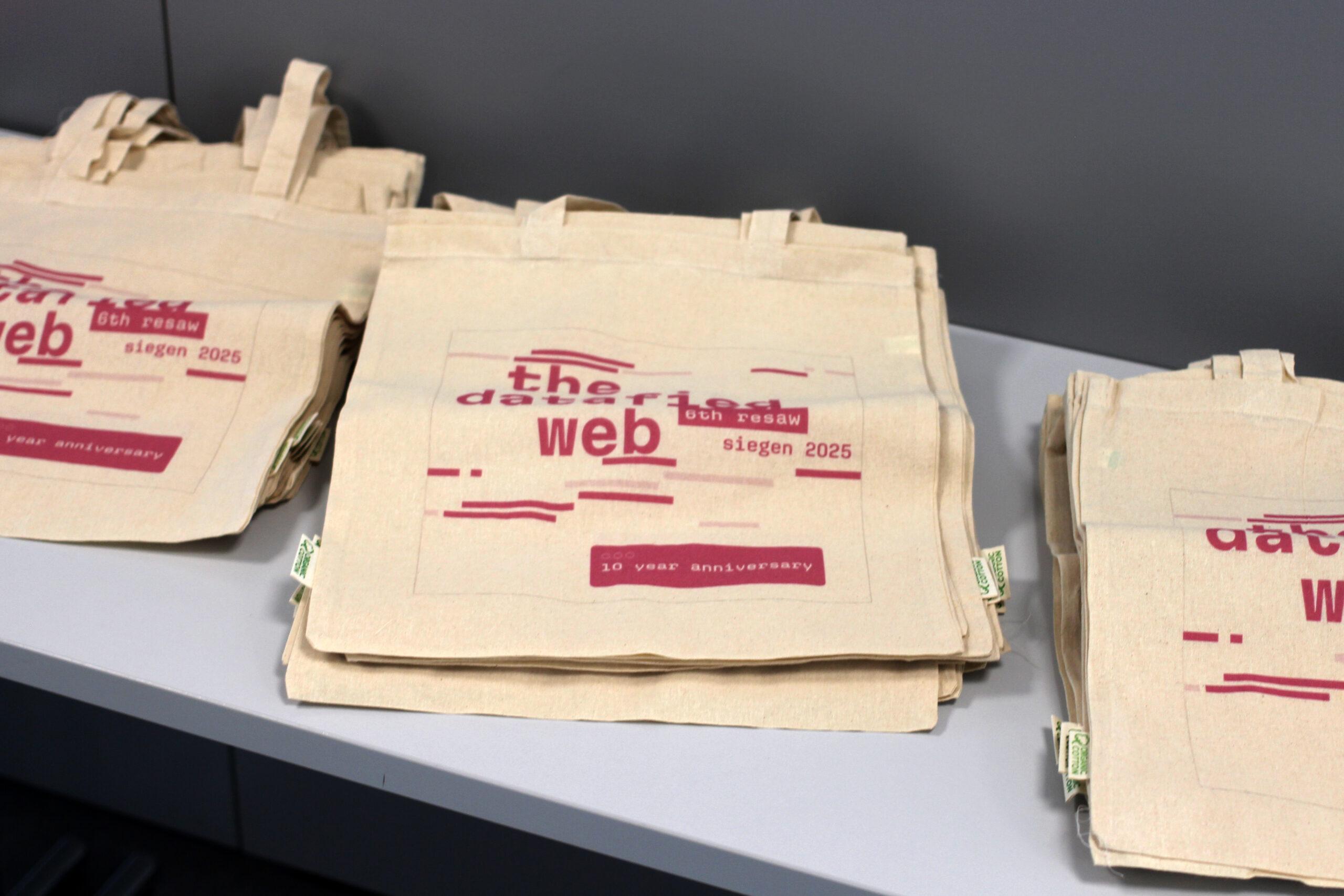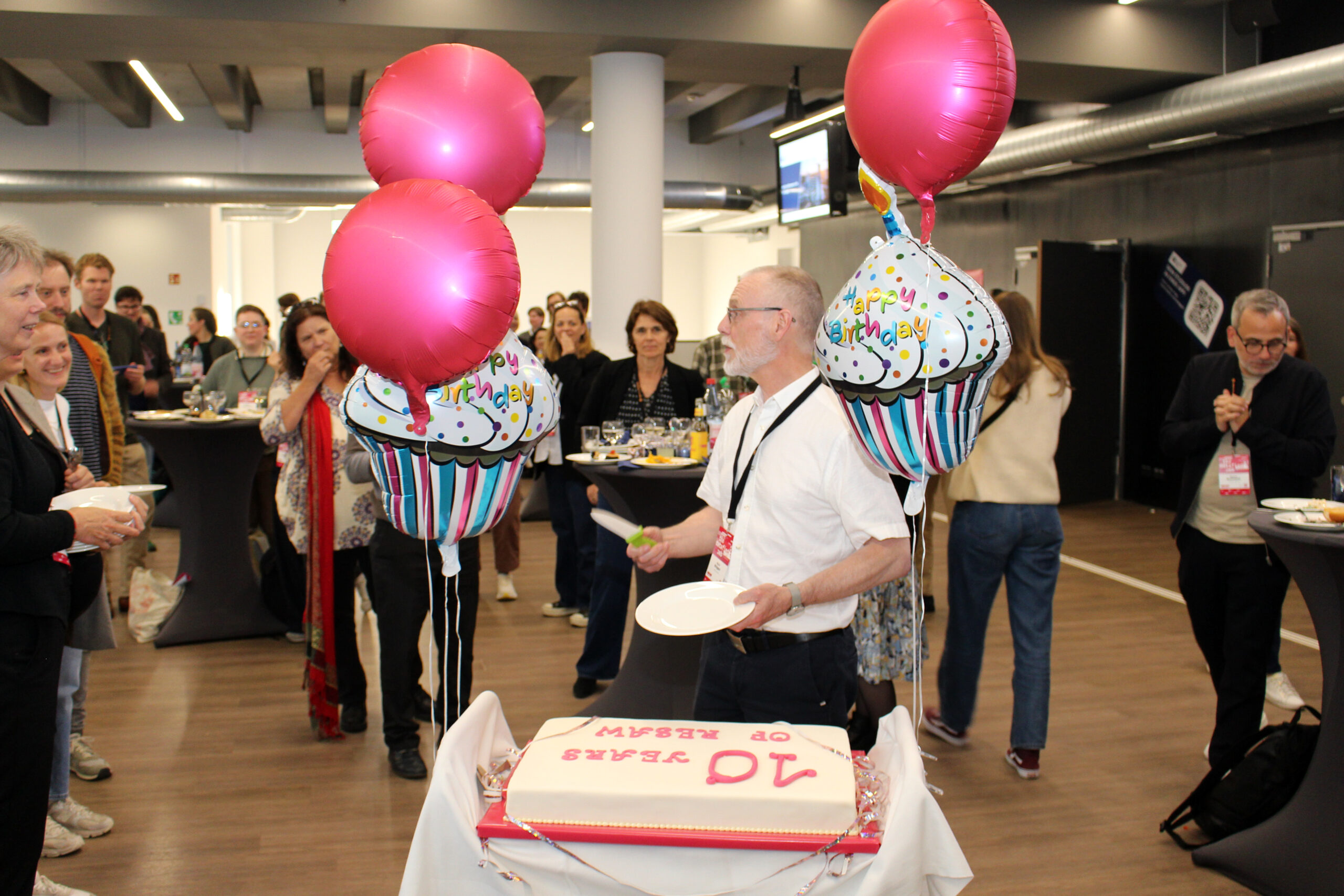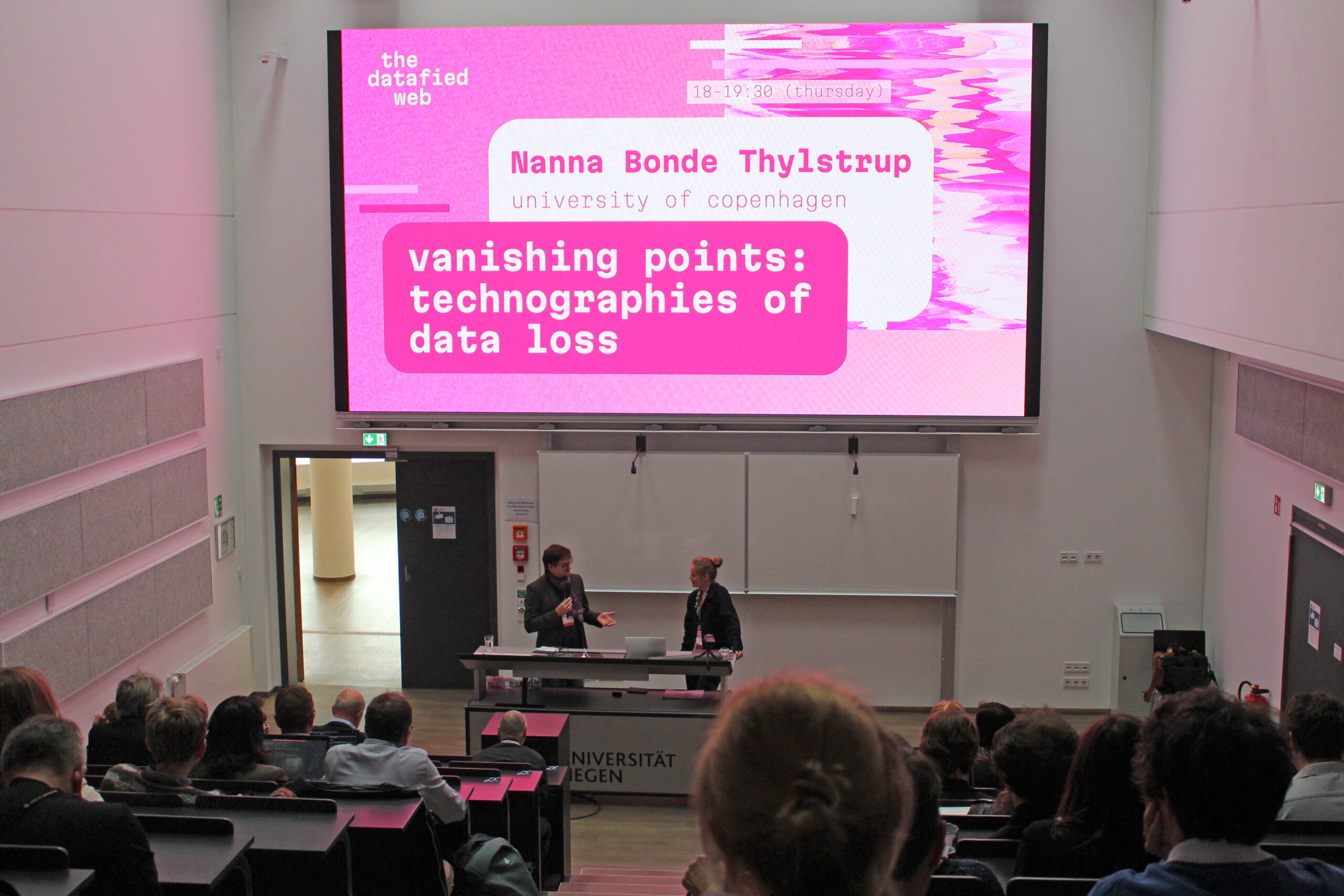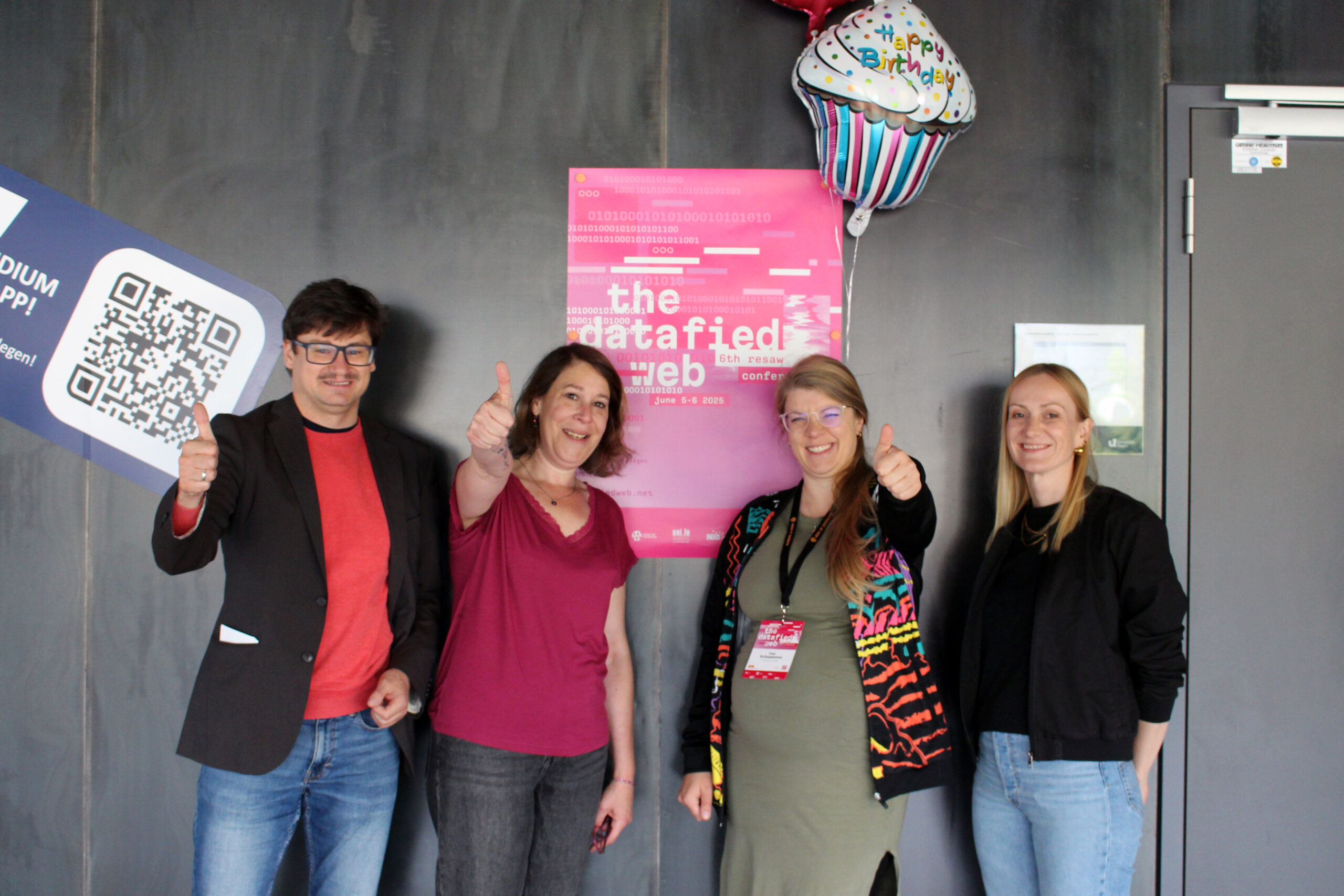News
Research on AI, Big Data Processing & Synthetic Media
The CRC “Media of Cooperation” launches its Critical Data School initiative at the University of Siegen with the international Autumn School “Synthetic Imaginaries: The Cultural Politics of Generative AI”.
The rise of artificial intelligence (AI), big data processing, and synthetic media has profoundly reshaped how culture is produced, made sense of, and experienced today. To ‘synthesize’ is to assemble, collate, and compile, blending heterogeneous components into something new. Where there is synthesis, there is power at play. Synthetic media—as exemplified by the oddly prophetic early speech synthesizer demos—carry the logic of analog automation into digital cultures where human and algorithmic interventions converge. Much of the research in this area—spanning subjects as diverse as augmented reality, avatars, and deepfakes—has revolved around ideas of simulation, focusing on the manipulation of data and content people produce and consume. Meanwhile, generative AI and deep learning models, while central to debates on artificiality, raise political questions as part of a wider social ecosystem where technology is perpetually reimagined, negotiated, and contested: What images and stories feed the datasets that contemporary AI models are trained on? Which imaginaries are reproduced through AI-driven media technologies and which remain latent? How do synthetic media transform relations of power and visibility, and what methods—perhaps equally synthetic—can we develop to analyze these transformations?
About the Autumn School
The five-day event at the University of Siegen explores the relationship between synthetic media and today’s imaginaries of culture and technology, which incorporate AI as an active participant. By “synthetic,” we refer not simply to the artificial but to how specific practices and ways of knowing take shape through human-machine co-creation. Imaginaries, in turn, reflect shared visions, values, and expectations—shaping not only what technologies do but how they are perceived and made actionable in everyday life.
Event Highlights
The five-day event features three keynotes and opens with a conference that brings together a total of six panels with contributions by scholars from Hong Kong, Norway, Australia, Germany, Austria, Romania, Slovenia, Spain, Taiwan, and the UK.
Our keynotes
- “Synthetic Narration: Do AI-generated stories flatten cultural diversity?” by Jill Walker Rettberg (Center for Digital Narrative, University of Bergen)
- “Synthetic situations: Ethnographic strategies for post-artificial worlds” by Gabriele de Seta (Center for Digital Narrative, University of Bergen)
- “Design Research with visual generative AI: failures, challenges, and research pathways” by Ángeles Briones (DensityDesign Lab, Politecnico di Milano)
From the second day onwards, the Autumn School moves into hands-on workshops and project work facilitated by a team of interdisciplinary scholars and data designers.
Mix questions! Monday, 8 September
Day one opens space for emerging questions—think of it as an idea hub. The panels explore diverse topics, from identities and digital narratives to platforms, infrastructures, and the politics of AI. The discussion-focused format invites participants to pose questions, share concepts, and highlight methodological challenges in an open exchange, rather than focusing on individual presentations.
Mix methods! Tuesday, 9 September-Thursday, 11 September
The next three days are about exploring new methods—hands-on! Each of our project teams will present a research question alongside a specific method to be collaboratively explored. Participants will not only learn how to design prompts and work with AI-generated text and images, but also how to critically account for genAI models as platform models. All projects draw on intersectional approaches, combining qualitative and quantitative data to explore the synthetic dimensions of AI agency—with contributions by Gabriele De Seta (University of Bergen), Marcus Burkhardt (University of Paderborn), Hendrik Bender (University of Siegen), Marloes Geboers (University of Amsterdam), Elena Pilipets (University of Siegen), Riccardo Ventura (Politecnico di Milano), Andrea Benedetti (Politecnico di Milano), Ángeles Briones (Politecnico di Milano), Carolin Gerlitz (University of Siegen), Sara Messelaar Hammerschmidt (University of Siegen), Jill Walker Rettberg (University of Bergen).
Synthesize! Friday, 12 September
The final day is dedicated to sharing, reflecting, and synthesizing the questions, methods, and insights developed throughout the week. Project teams will present their collaborative processes, highlight key takeaways, and discuss how their ideas and approaches shifted through hands-on experimentation with methods.
The Autumn School is organized by the DFG-funded Collaborative Research Centers Media of Cooperation (SFB 1187) and Transformations of the Popular (SFB 1472) together with the Center of Digital Narrative in Bergen, the Digital Culture and Communication Section of ECREA and the German National Research Data Infrastructure Consortium NFDI4Culture.

STELLENAUSSCHREIBUNG:
Du bist interessiert, organisiert und hast Lust, in einem kleinen Team in die spannende und abwechslungsreiche Welt der wissenschaftlichen Arbeit einzutauchen? Veranstaltungen mitzugestalten und bei der Datenerhebung mitzuwirken klingt nach deinem Ding und du möchtest Wissenschaft online und offline erlebbar machen? Dann suchen wir genau dich!
SHK/WHB-Stelle im SFB-Teilprojekt A04 „Normale Betriebsausfälle. Struktur und Wandel von Infrastrukturen im öffentlichen Dienst“
Im DFG-Sonderforschungsbereich 1187 „Medien der Kooperation“ suchen wir eine studentische Hilfskraft (SHK) oder eine wissenschaftliche Hilfskraft mit Bachelor-Abschluss (WHB) für das Teilprojekt A04 „Normale Betriebsausfälle. Struktur und Wandel von Infrastrukturen im öffentlichen Dienst“ des zum
1. November 2025 zu folgenden Konditionen:
- 9 Stunden/Woche
- zunächst für 1 Jahr, mit der Möglichkeit einer Verlängerung
- Beschäftigung auf Grundlage des Wissenschaftszeitvertragsgesetzes
Was dich bei uns erwartet:
- Sozial- und Medienwissenschaften praxisnah: Du interessierst dich für Themen der Mobilität, Nachhaltigkeit und den Wandel unserer Gesellschaft. Deine Mithilfe bei der Recherche von passender Literatur, der Aufbereitung und Auswertung von Forschungsdaten ist gefragt.
- Hands-on bei Events: Deine Ideen und Hände sind gefragt. Hilf mit bei der Organisation und Durchführung öffentlicher Veranstaltungen, z.B. Workshops und Tagungen.
Was du mitbringen solltest:
- Du bist in Sozialwissenschaft oder Medienwissenschaft mit sozialwissenschaftlichen Schwerpunkt immatrikuliert.
- Du hast Spaß daran, Dinge zu organisieren und an Forschung mitzuwirken.
- Du arbeitest strukturiert, bist eigenständig und verantwortungsbewusst.
Was wir dir bieten:
- Ein motiviertes, nettes Team und eine entspannte Arbeitsatmosphäre.
- Flexible Arbeitszeiten und Homeoffice-Möglichkeit – damit Uni und Job zusammenpassen.
- Spannende Einblicke in die Projektarbeit und Wissenschaftsorganisation.
Klingt gut? Dann schick uns eine kurze Bewerbung bis zum 12.09.2025 und zeig uns, warum du perfekt in unser Team passt. Sende deine Bewerbungsunterlagen (kurzes Motivationsschreiben, Lebenslauf, ggf. Arbeits- und/oder Studienzeugnisse) in einer pdf-Datei an Damaris Lehmann (damaris.lehmann[ae]uni-siegen.de). Wir freuen uns darauf, dich kennenzulernen.
Deine Ansprechperson:
Damaris Lehmann
damaris.lehmann[ae]uni-siegen.de
About drivers of the fourth industrial revolution
About the special issue
Digital twins are currently the most important drivers of the fourth industrial revolution. Ever more complex technical products and processes are now developed and tested in the virtual sphere before they emerge in the “real” world. Future artefacts and practices are first produced as software models and simulated as digital twins. The prevalence of digital twins in industry and research creates a fundamental paradigm shift in digital-media technologies. The digital is neither a real-time virtual representation of a real-world physical object nor an entirely separate object: it is much more, for it allows for the analysis of future performances of objects without the physical presence of these objects.
Digital twins represent the techno-ideological paradigm of our time. They have their own ethos in the context of a technocratic view of the world, which presumes that everything observable or at least sense-able can also be made countable, accountable, and computable. While digital twinning originally only involved technical systems, it nowadays also predicts other parameters, such as human movement patterns and occasionally also social aspects. Digital twins are thus emblematic and paradigmatic of a technocratic view of the world defined by the belief that everything can be calculated and controlled. Digital twins are technopolitical artefacts, or rather, they are inscribed with a techno-ecology, as they are increasingly involved in institutional decision-making that can ultimately affect us all. It is in this context that digital twins unfold their true power.
Christoph Borbach, Wendy H.K. Chun, and Tristan Thielmann took this situation as an opportunity to co-edit a special issue of New Media & Society on “Digital Twinning”. The special issue is now available online, with most contributions in open access. Their co-authored editorial “Making everything ac-count-able: The digital twinning paradigm” can be found here.
Some of the contributions are related to the 2023 annual conference of the CRC 1187 on “Digital Twins & Doubles. Data of Cooperations.”
Information events on the introduction of electronic patient records
As part of an information and discussion event, researchers from the University of Siegen provided information about the use of electronic patient records. In addition to providing general information, they offered citizens the opportunity to discuss open questions and concerns surrounding the topic.
About the event
In cooperation with the Digital Specialist and Health Center (DFGZ) of the medical office “Spieren & Kollegen,” subproject 4 “Health and Aging” of the FUSION research project, together with the subproject of CRC A05 “Cooperative Creation of User Autonomy in the Context of an Aging Society” has already held two information and discussion events on the introduction of electronic patient records (ePA). The central concern of those involved is to remove the barriers to the use of ePA for citizens and to support the transfer of knowledge among medical practices in South Westphalia. In addition to providing general information on electronic patient records, the events also offered an opportunity to discuss open questions and concerns surrounding the topic.
Claudia Müller, head of both research projects, commented that such events naturally do not reach a mass audience, but that there is hope that many of the more than 100 participants in the two ePA events will act as multipliers. One challenge is that not everyone has the same skills or technical capabilities to actually use the electronic patient record themselves. Although this is not a problem specific to the ePA, it must be taken into account in times of increasing digitalization and online offerings, Müller continued.
Dennis Kirschsieper, a member of the CRC’s subproject A05, and Dr. Stephan Krayter, a member of the FUSION project, have been involved in the project from the outset and explain:
“When new technologies are introduced, it is common for some people to try them out and use them immediately out of curiosity – so-called ‘technology pioneers’ or ‘early adopters’ – while others are more hesitant to embrace the new, preferring to watch others and wait and see. By sharing the experiences of early adopters, we are helping to make it easier for others to get started with electronic patient records.”
Upcoming interview study: Call for participation
Following the successful introduction of the ePA, the main focus now is on supporting the exchange of information regarding problems with the electronic patient record and accompanying the introduction and actual use of the ePA by citizens with a qualitative interview study.
The research team is calling for participants to take part in this study. The aim of the study is to collect and scientifically evaluate users’ experiences with the electronic patient record.
Dennis Kirschsieper: dennis.kirschsieper[æt]uni-siegen.de oder 0271 / 740-2002
Dr. Stephan Krayter: stephan.krayter[æt]uni-siegen.de oder 0271 / 740-3833
Interesse an Tätigkeit im wissenschaftlichen Umfeld?
Im Teilprojekt B06 “Un/erbetene Beobachtung in Interaktion: Smart Environments, Sprache, Körper und Sinne in Privathaushalten” des DFG Sonderforschungsbereichs 1187 „Medien der Kooperation“ suchen wir eine studentische Hilfskraft (SHK) (m/w/d) zum 01. August 2025 zu folgenden Konditionen:
- Bis zu 10 Wochenstunden (genaue Stundenzahl nach Vereinbarung)
- Zunächst befristet für ein Jahr, mit der Möglichkeit zur Verlängerung
- Beschäftigung auf Grundlage des Wissenschaftszeitvertragsgesetzes
Ihre Aufgaben:
- Aufbereitung und Transkription von Feldnotizen sowie Teilnahme an der Auswertung des Datenmaterials
- Unterstützung bei Zuarbeit für die Forschung (u.a. Literaturrecherche und -verwaltung)
- Unterstützung bei der Durchführung von Veranstaltungen (u.a. in der Planung und praktischen Durchführung von Tagungen und Workshops)
- Mithilfe bei der Erstellung wissenschaftl. Publikationen (z.B. Korrektorat, Formatierungsarbeiten) )
Ihr Profil:
- Vorteilhaft ist die Vertrautheit mit empirischem Arbeiten
- Bereitschaft für flexible Arbeitszeiten
- Immatrikulation in einem (bevorzugt sozial- oder medienwissenschaftlichen) Bachelor- oder Master-Studiengang an einer deutschen Hochschule (bevorzugt Uni Siegen)
- Interesse an einer Tätigkeit im wissenschaftlichen Umfeld
- Strukturiertes Arbeiten, Freude an Teamarbeit, Eigeninitiative und Verantwortungsbewusstsein
→ vollständige Stellenausschreibung
Wir freuen uns auf Ihre Bewerbung bis zum 21.07.2025.
Bitte senden Sie Ihre Bewerbungsunterlagen (Anschreiben, tabellarischer Lebenslauf, Zeugnisse) in einer einzigen pdf-Datei an Herrn Strüver.
Weitere Infos zu dem Projekt erhalten Sie hier: https://www.mediacoop.uni-siegen.de/de/projekte/b06/
Ihre Ansprechperson:
Niklas Strüver, M.A.
niklas.struever[æt]uni-siegen.de
On Pre-technological Media
by Erhard Schüttpelz (University of Siegen/CRC)
If we have always lived in a media society, what are media actually? Erhard Schüttpelz explores this question in his new book Medium, Medium: Elemente einer Anthropologie (Medium, Medium: Elements of an Anthropology).
About the Book
Nowadays, the term “medium” is often used in connection with technology, although media have long existed in other mediating roles between humans and non-humans. With this study, Schüttpelz shifts the perspective of media studies and asks the question of what media actually are.
Editoral text:
When we think of media, we usually have in mind its manifestation in technical devices, from the first telegraph to today’s communication and storage media. This ignores the fact that the term medium also has a meaning that existed before technology, in which it refers to those who can mediate between heaven and earth, between the living and the dead, between those present and those absent. If mediality can be understood over millennia as a practice that connects humans and non-humans, a rupture takes place in the modern age: Media fall into one with technology, and a diverse strangeness of media becomes an interplay of prosthesis and remote control.
In his groundbreaking study, Erhard Schüttpelz shifts the perspective of media studies: from weapon to container, from writing to language, from magic to ritual. And he poses the question of what media actually are if we have always lived in media societies.
About the Author
Erhard Schüttpelz has been Professor of Media Theory at the University of Siegen since 2005 after studying German, English and Ethnology in Hanover, Exeter and Bonn and conducting research in Oxford, Cologne, New York, Constance and Vienna. He is the principle investigator of the project P02 “Media of Praxeology II: Anthropology of Cooperation: Skill, Deixis, Interaction” at the CRC 1187.
How does intelligent, sensor-based media technologies change everyday household practices?
by Tim Hector, Niklas Strüver, Stephan Habscheid and Dagmar Hoffmann (all Siegen University, CRC)
In our new Working Paper (No. 36) “Sensory Practices in the Smart Home. Findings and Methodological Reflections from an Interdisciplinary Pilot Study”, Tim Hector, Niklas Strüver, Stephan Habscheid and Dagmar Hoffmann present the first results of their interdisciplinary pilot study on how smart home devices change household ecologies and processes. The study is part of their research project at the CRC, which studies the domestication of smart technologies as a case of cooperative production of media and data.
About the Working Paper
The working paper presents, as a proof of concept, initial findings from an interdisciplinary pilot study that employs methods from sociological and linguistic media research to investigate how everyday household practices are represented and transformed through smart, sensor-based media technologies, which can be observed as multimodal interactions. Within the framework of the project “B06 – Un-/Desired Observation in Interaction: Smart Environments, Language, Body, and Senses in Private Households” in the Collaborative Research Center “Media of Cooperation”, the domestication of smart technologies is examined as a case of the cooperative production of media and data—both with and without consent (Star and Griesemer 1989).The focus of the presented pilot study is on human-machine cooperation, in which the more or less noticeable capture of behavioral and environmental data by sensors contributes to the semi-automated shaping of household ecologies and processes. We reconstruct and analyze forms of interaction and communication with interfaces of these modern technologies, as well as the sensory orientations and bodily practices of users. Furthermore, we examine the spatial and material arrangements that are essential for the social and communicative organization, as well as the purposiveness and goal-directedness of socio-technical actions involving these devices. We present exploratory media-sociological and media-linguistic analyses of a living environment equipped with smart devices, exemplified by two specific devices: an Amazon Echo Show (10th gen.), a ‘rotating’ smart speaker with a voice user interface, camera, display, video/touch screen, and camera-based motion detection, and a smart, internet-connected air fryer. The study demonstrates that users are embedded in human-machine interaction through their human sensorium—both socio-cognitively and physically—and are challenged in situ to make various decisions.
About the auhtors
Tim Hector (Dr. des.) works as a researcher at the Collaborative Research Center 1187 »Media of Cooperation« in the project B06 »Un/desired Observation in Interaction: Smart Environments, Language, Body and Senses in Private Homes« at Siegen University. He did a PhD in applied linguistics on the linguistic domestication of voice assistants. His research interests include media and cultural linguistics, conversation analysis linguistic domestication of media technologies and spoken language in human-computer-interaction. Niklas Strüver (M.A.) works as a researcher at the Collaborative Research Center 1187 »Media of Cooperation« in the project B06 »Un/desired Observation in Interaction: Smart Environments, Language, Body and Senses in Private Homes« at Siegen University. He is a doctoral student at the graduate school MGK of the CRC, studying Voice Assistants as sociotechnical phenomena.
Stephan Habscheid (Prof. Dr.) is a professor of German studies and applied linguistics at Universität Siegen. He is principal investigator of the interdisciplinary project B06 »Un/desired Observation in Interaction: Smart Environments, Language, Body and Senses in Private Homes« at the Collaborative Research Center 1187 »Media of Cooperation«, Universität Siegen (together with Dagmar Hoffmann). His research interests include media linguistics, linguistic praxeology, language in institutions and organizations as well as small talk and conversation. Dagmar Hoffmann (Prof. Dr.) is a professor of media sociology and gender media studies at Universität Siegen, Germany. She is principal investigator in the interdisciplinary project B06 »Un/desired Observation in Interaction: Smart Environments, Language, Body and Senses in Private Homes«« at the Collaborative Research Center 1187 »Media of Cooperation«, Universität Siegen (together with Stephan Habscheid). Her research is focused on media and cultural sociology, digital literacy, and political participation.
Über die Working Paper Reihe
The Working Paper Series of the Collaborative Research Center 1187 „Media of Cooperation“ promotes inter- and transdisciplinary media research. The CRC Working Paper Series provides an avenue for rapid publication and dissemination of ongoing research at or associated with the CRC. The Working Paper Series aims to circulate in-progress research to the wider research community beyond the CRC. Publication in the Working Paper Series does not preclude publication of a more developed version of the same paper in another journal. Contributions from established academics and postdoctoral researchers are welcome. The articles are published in open access and a limited number of print copies. We ask interested parties to send a paper proposal (max. 300 words) and a short biographical note (max. 50 words). Please follow our style guide for manuscript submission.
Funded by the German Research Foundation (DFG) – Project number 262513311 – SFB 1187 Media of Cooperation. Series’ editor: Dr. Karina Kirsten, University of Siegen & CRC 1187 Media of Cooperation.
The 2025 RESAW Conference: Data, Communities, and Food … for Thoughts
by Valérie Schafer (University of Luxembourg & CRC 1187)
The 2025 edition of the RESAW conference marked a significant milestone: the tenth anniversary of a vibrant and constantly evolving academic community. Since its inception in 2015, this conference series has brought together researchers, archivists, and practitioners from diverse fields concerned with the history and present of the web. This year’s event was memorable, not only because of the anniversary, but also due to the remarkable richness of the exchanges, the diversity of its participants, and the depth of the contributions. RESAW joined forces with the Collaborative Research Centre (CRC 1187) Media of Cooperation, both coming together to study The Datafied Web and to preserve its histories.
About the RESAW conference and community
RESAW is the acronym for A REsearch Infrastructure for the Study of Archived Web Materials. The RESAW community is dedicated to working with digital cultural heritage and gathers every two years at the eponymous RESAW conference. RESAW was founded in 2012 with the goal of building a collaborative European research infrastructure for studying and working with web materials while fostering knowledge exchange across Europe. This presents significant challenges for both research and the archiving of web-based information and objects.
RESAW 2025 – The datafied Web at the University of Siegen
The conference drew close to one hundred participants from across Europe and North America. Among them were long-standing members of the community – some of whom have attended every edition since the beginning, as well as many newcomers, and notably from the CRC team at the University of Siegen. This mix created a dynamic and productive atmosphere, with new ideas and connections flourishing. It provided intellectual renewal and disciplinary cross-pollination.
The central theme, The Datafied Web, acted as a powerful conceptual anchor, encouraging reflection on how datafication has been and is reshaping the web, our methods, and our understanding of digital studies and web archives.
While many presentations were directly aligned with the theme, the conference also remained open to a wide array of topics beyond the scope of datafication. This flexibility is a longstanding strength of the event, allowing space for discussions of current research developments, methodological experimentation, and new discoveries in the fields of web archiving and web studies. Contributions ranged from updates on national and international web archiving initiatives to exploratory studies in platform studies or qualitative and quantitative methods.
RESAW set out to trace how the datafied web became the sensory media environment we now inhabit. A web of predictive suggestion, of per-user variation, of AI-generated aesthetic and ephemeral interfaces. A web where “what you see” is a product of where you clicked, what you hovered, which model you unknowingly trained. To study this web—and to preserve its histories—that is where the research agendas of Resaw and MoC come together. (Carolin Gerlitz, spokesperson of the CRC 1187)
A significant number of talks examined The Datafied Web through historical perspectives. These included case studies on the evolution of technologies such as the CD-ROM and Bluetooth, and their interaction with or transition into web-based platforms, shedding light on the frictions and continuities involved. Others focused on pressing current concerns, such as data surveillance, algorithmic governance, and the political economy of web and platform infrastructures.
The datafication of the web has brought about a decisive transformation of capitalism – and capitalist economies have in turn datafied the World Wide Web. Our current platform economies are based on the historical development of cookies, web advertising, and the measurement of public data. (Sebastian Gießman, head of the conference)
The interdisciplinary character of the conference was particularly evident this year. Approaches drawn from Web and Platform Studies, the History of Technology, Archival Studies, Digital Humanities, and Critical Data Studies were all present, and in fruitful dialogue. This interdisciplinarity was reflected not only in the themes discussed, but also in the methods employed: from close analysis to distant and scalable reading, and from infrastructure-focused studies to content-based investigations. Such methodological diversity illustrates the richness of the field and the necessity of hybrid approaches to fully grasp the complexities of the web’s past, present and future.
The keynote addresses were among the highlights of the conference. Nanna Bonde Thylstrup’s keynote offered a historically grounded presentation on the theme of data loss, linking it to broader narratives of memory, preservation, and forgetting in the digital age. Jonathan Gray’s keynote, by contrast, was more oriented toward the present and near future, addressing the stakes of open data, and the role of researchers in shaping ethical and inclusive data practices.
Beyond the formal sessions, a variety of pre-workshops, social events, and targeted meetings enriched the experience. Early-career researchers were given space to receive feedback and engage in mentoring dialogues. Pre-conference workshops offered hands-on methodological training and collaborative problem-solving. Roundtables tackled timely and strategic questions, such as the future of our scholarly RESAW network, and the challenges of studying datafication in the opening roundtable. (A personal conference trip report by Lesley Frew that focuses on her experience and some of the sessions is also available).
Of particular note was the attention paid to the epistemological and methodological implications of working with web data. Whether focusing on the politics of web archiving, the limits of data transparency, or the possibilities of algorithmic critique, many sessions interrogated not only what we know, but how we come to know it and what remains excluded or erased in the process. Case studies drawn from diverse geographical, historical and linguistic contexts further enriched these discussions, reminding us of the web’s heterogeneity and the need for grounded, situated and reflexive perspectives.
In conclusion, the 2025 conference was more than just a commemoration of ten years of scholarly exchange and conferences. It was a powerful reaffirmation of the value of community, dialogue, and interdisciplinary collaboration in the face of a rapidly evolving digital landscape and more generally world. The themes explored, the connections made, and the questions raised will no doubt continue to inspire work in the years to come.
We would like to sincerely thank again all the local organisers, all the participants who made this edition such a success, as well as the DFG and FNR, the University of Siegen, the CRC Media of Cooperation, and the C2DH at the University of Luxembourg for their support to this event.
The 2025 RESAW conference was organized by the Collaborative Research Centre 1187 “Media of Cooperation” at the University of Siegen in cooperation with the Centre for Contemporary and Digital History (C²DH) at the University of Luxembourg. The conference is funded by the Deutsche Forschungsgemeinschaft (DFG, German Research Foundation) and the Luxembourg National Research Fund (FNR).
More
Press release by the University’s Press Office →
Conference report by Lesley Frew →
The CRC grants two scholarships
The CRC awards two short-term scholarships to promote the work of early-career researchers who are conducting research in the field of digital media, sensing and sensor technology, data practices and AI and are interested in a longer-term collaboration with the CRC.
Info
- duration: 9-12 months
- The basic amount of the scholarship is based on the maximum rate of the DFG (1.365,- EUR). In addition, an allowance for material expenses and, if applicable, a child allowance will be paid.
- Basic amount of the scholarship: EUR 1,365 (maximum DFG rate)
- Material cost allowance and, if applicable, child allowance are paid in addition
About the CRC 1187 “Media of Cooperation“
The CRC is an interdisciplinary collaborative research centre consisting of 19 subprojects and more than 60 researchers from media studies, ethnology, sociology, computer science, linguistics, ubiquitous computing, science and technology studies, education, law and engineering.
The Collaborative Research Centre 1187 has been funded by the German Research Foundation (DFG) since 2016. The research centre studies digital media, which have emerged as cooperative tools, platforms and infrastructures on a broad front, and approaches them as cooperatively accomplished means of cooperation. In the first funding phase (2016-2019), the CRC focused on the relevance of social media and platforms, while the second phase (2020-2023) centered on data-intensive media and data practices. Phase 3 (2024-2027) inquires the interplay between sensor media and artificial intelligence.
The short-term fellowship program of the CRC provides national and international doctoral students the opportunity to further develop their research project in the CRC, to get to know participating researchers and to exchange ideas with them. The research projects of the scholarship holders should be thematically related to the subprojects of the CRC, so that their work can be supported by the principal investigators and their teams. Scholarship holders are assigned to the Integrated Research Training Group (MGK) of the CRC and benefit from its structured training program. The CRC offers scholarship holders an international environment for interdisciplinary media research as well as an extensive program of events and training in ethnographic, digital, sensor-based, linguistic, and AI-based methods.
Further information on the CRC’s research agenda and subprojects can be found at https://www.mediacoop.uni-siegen.de/en.
Your Profile
- Relevant, above-average degree in one of the disciplines participating in or related to the CRC, preferably in media and cultural studies, sociology or in the field of socio- or business informatics, human-computer interaction or information systems (equivalent to a Master’s degree, Magister, Diplom or Lehramt/Staatsexamen Sek. II)
- Individual research project in one of the above-mentioned disciplines within the subject area of the CRC. Ideally, you can assign the project to one of the subareas of the CRC: infrastructures, publics, or sensory praxeology
- Interest in methods of media research, the analysis of data practices and an affinity for working in an interdisciplinary research environment
- Willingness to participate in the international event program of the CRC and the MGK
- Very good written and spoken English language skills
Your Tasks
Expectations of successful candidates:
- Regular participation and involvement in the events and the training program of the MGK (colloquia, workshops, summer schools, methodology workshops, interdisciplinary groups)
- Presentation of preliminary results of the individual research project within the MGK colloquium
About the application
Please send your application documents (letter of motivation, curriculum vitae, copies of certificates, 5-10-page outline of a project idea) as a single PDF file (max 5 mb) to dominik.schrey@uni-siegen.de by 25 June 2025. Please note that risks to confidentiality and unauthorized access by third parties cannot be ruled out when communicating by unencrypted e-mail.
About the University
The University of Siegen is an interdisciplinary and cosmopolitan university with currently around 18,000 students and a range of subjects from the humanities, social sciences and economics to natural sciences, engineering and life sciences. With over 2,000 employees, we are one of the largest employers in the region and offer a unique environment for teaching, research and further education.
Equal opportunities and diversity are promoted and actively practiced at the University of Siegen. Applications from women are highly welcome and will be given special consideration in accordance with the federal state equality law. We also welcome applications from people with different personal, social and cultural backgrounds, people with disabilities and those of equal status.
Information about the University of Siegen can be found on our homepage: www.uni-siegen.de.
For further information, please contact
Dr. Dominik Schrey
Phone: +49 (0) 271 740-4664
E-Mail: dominik.schrey@uni-siegen.de
1 / 16

